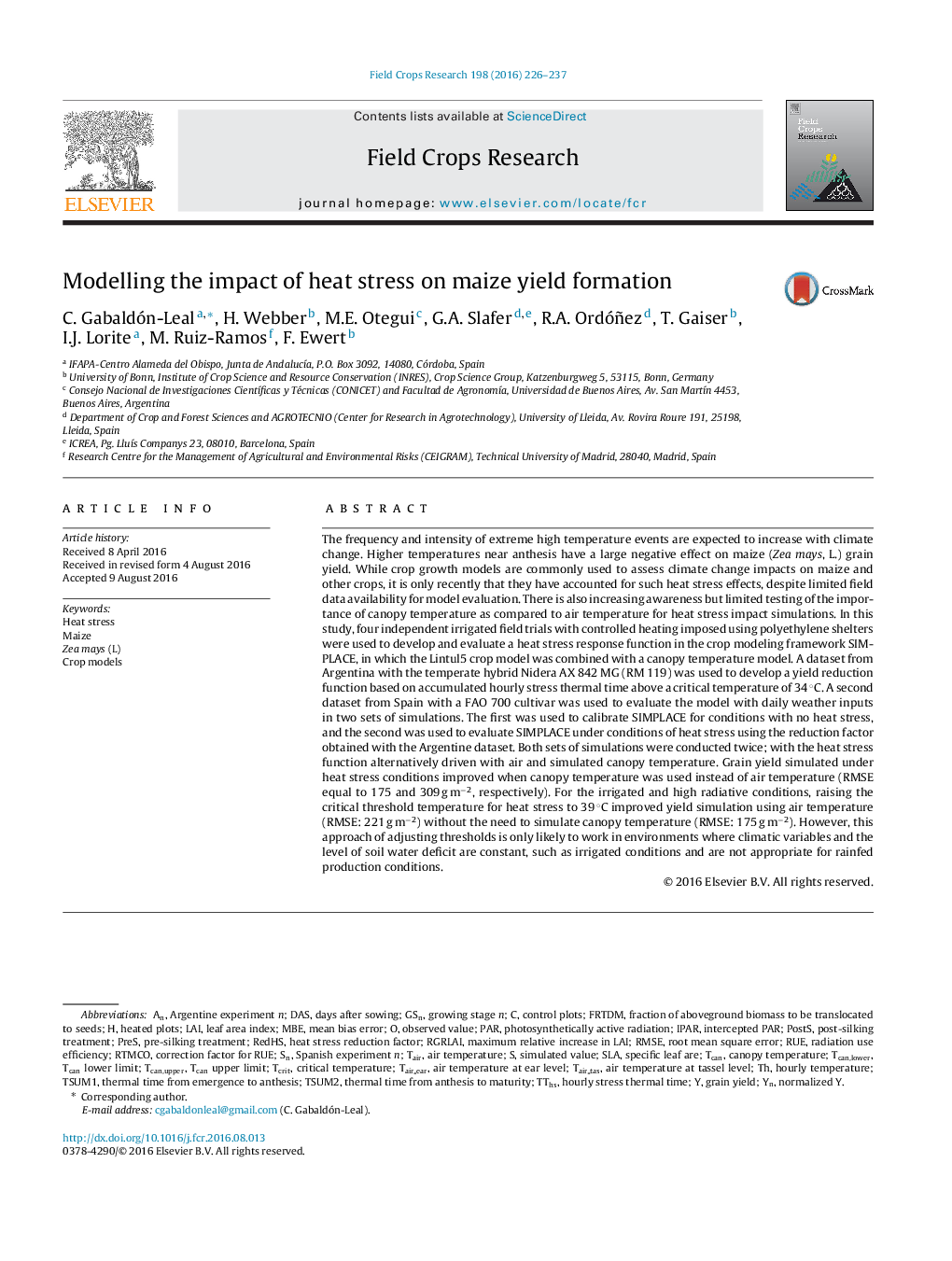| کد مقاله | کد نشریه | سال انتشار | مقاله انگلیسی | نسخه تمام متن |
|---|---|---|---|---|
| 6374406 | 1624665 | 2016 | 12 صفحه PDF | دانلود رایگان |
عنوان انگلیسی مقاله ISI
Modelling the impact of heat stress on maize yield formation
ترجمه فارسی عنوان
مدل سازی تأثیر تنش گرمائی بر شکل گیری عملکرد ذرت
دانلود مقاله + سفارش ترجمه
دانلود مقاله ISI انگلیسی
رایگان برای ایرانیان
کلمات کلیدی
SLATCANIntercepted PARMBEGSNPRESDASRMSEHeat stress - استرس گرماییRadiation use efficiency - بهره وری استفاده از تابشPhotosynthetically active radiation - تابش فعال فتوسنتزیPar - توسطMean bias error - خطای اشتباه متوسطCritical temperature - دمای بحرانیCanopy temperature - دمای سایبانAir temperature - دمای هواMaize - ذرت یا جواریdays after sowing - روز بعد از کاشتRUE - روپیهRoot mean square error - ریشه میانگین خطای مربعTair - سهLeaf area index - شاخص سطح برگLAI - شبیهIPAR - صنعتGrain yield - عملکرد دانهCrop models - مدل های محصولPOSTS - پست ها
موضوعات مرتبط
علوم زیستی و بیوفناوری
علوم کشاورزی و بیولوژیک
علوم زراعت و اصلاح نباتات
چکیده انگلیسی
The frequency and intensity of extreme high temperature events are expected to increase with climate change. Higher temperatures near anthesis have a large negative effect on maize (Zea mays, L.) grain yield. While crop growth models are commonly used to assess climate change impacts on maize and other crops, it is only recently that they have accounted for such heat stress effects, despite limited field data availability for model evaluation. There is also increasing awareness but limited testing of the importance of canopy temperature as compared to air temperature for heat stress impact simulations. In this study, four independent irrigated field trials with controlled heating imposed using polyethylene shelters were used to develop and evaluate a heat stress response function in the crop modeling framework SIMPLACE, in which the Lintul5 crop model was combined with a canopy temperature model. A dataset from Argentina with the temperate hybrid Nidera AX 842 MG (RM 119) was used to develop a yield reduction function based on accumulated hourly stress thermal time above a critical temperature of 34 °C. A second dataset from Spain with a FAO 700 cultivar was used to evaluate the model with daily weather inputs in two sets of simulations. The first was used to calibrate SIMPLACE for conditions with no heat stress, and the second was used to evaluate SIMPLACE under conditions of heat stress using the reduction factor obtained with the Argentine dataset. Both sets of simulations were conducted twice; with the heat stress function alternatively driven with air and simulated canopy temperature. Grain yield simulated under heat stress conditions improved when canopy temperature was used instead of air temperature (RMSE equal to 175 and 309 g mâ2, respectively). For the irrigated and high radiative conditions, raising the critical threshold temperature for heat stress to 39 °C improved yield simulation using air temperature (RMSE: 221 g mâ2) without the need to simulate canopy temperature (RMSE: 175 g mâ2). However, this approach of adjusting thresholds is only likely to work in environments where climatic variables and the level of soil water deficit are constant, such as irrigated conditions and are not appropriate for rainfed production conditions.
ناشر
Database: Elsevier - ScienceDirect (ساینس دایرکت)
Journal: Field Crops Research - Volume 198, November 2016, Pages 226-237
Journal: Field Crops Research - Volume 198, November 2016, Pages 226-237
نویسندگان
C. Gabaldón-Leal, H. Webber, M.E. Otegui, G.A. Slafer, R.A. Ordóñez, T. Gaiser, I.J. Lorite, M. Ruiz-Ramos, F. Ewert,
